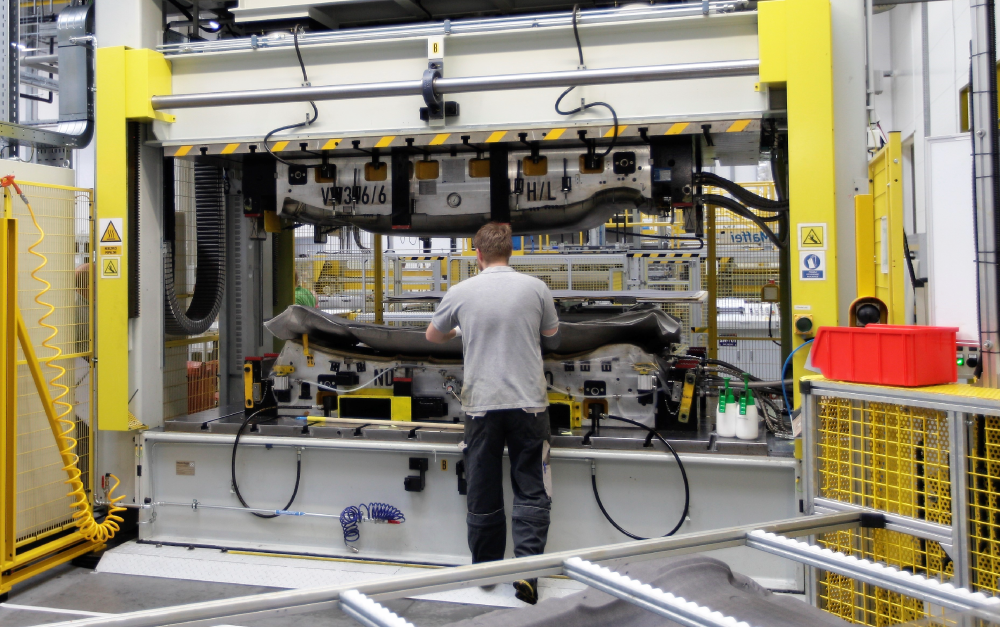Five tips for successfully digitalising a plastics production line
- Digital Factory
- Article
Plastics manufacturing is a knotty problem for digitalisation – but it can be untangled successfully. A typical production hall is furnished with variously old presses from a variety of manufacturers. Each one has a different communication standard, e.g. OPC DA, OPC UA or Euromap 73 or 77. How can you collect operator and machine data in this complicated environment human-free? Can you stay constantly informed and in charge of every event? Take inspiration from the story of this company that presses plastics for the leading automakers and gain a guide on how to implement projects successfully.
Error-prone retroactive production recording
The management of this automotive plastics company needed to know what was really happening in real time on its shop floor. Before digitalisation, accompanying documents were generated based on the production plan and provided to foremen on paper, and individual operators filled out dispatch notes / shift reports on their work performed. An assigned person then transcribed the data into electronic form (typically Excel). But this approach brought a number of limitations. Production was always recorded retroactively, one to two days after the fact; it was difficult to check for errors; information was imprecise. Operators could report work they had not actually performed. In certain cases they could also log into two work centres at once.
Precise machine data, visualisations and motivations
In the first phase of the MES project, a sample work centre with a variety of machine types was equipped with a touch terminal for operators. A machine was hooked up over a data interface, and the machine’s processes for operator login and logout, order commencement, downtimes, and downtime reasons were defined. Work reports are now generated in the MES based on an operator’s logging into an order. The foreman tells the operator which work centre to go to. The operator then logs into the terminal using an RFID card and begins work on their shift. This is a multi-operation work centre. Terminals are always at the end of the production line, not at every machine.
Order prioritisation is designated by the plan from the ERP. The operator commences the order and, if there is downtime, records the reason for it. Upon pallet finalisation, they perform production registration and confirm the number of units. The data is exported to the ERP and is also used for calculating operators’ wages. The MES imports information on the number of operators for a given operation, checks the optimal number of people for operations and takes in master data from the ERP for optimisation of costs. Reporting is another integral part of this project; it visually provides information and shows trends for downtimes and the causes of scrap generation over time. The reports display and categorise the production line’s takt time on a timeline and performance in each of the three shifts.
Deploying a MES also increases worker motivation. Displaying work-centre and attendance data helps them to meet standards.
Collection of machine-processing data, notifications for the quality and maintenance teams, and escalation
For the project’s second phase, machines were hooked up to the pilot work centres over an OPC server, and takt times began to be collected. Tool deployments are now registered, and downtimes are recorded automatically. When a takt does not complete within the defined time, the work centre reports downtime. For reconnection, the operator must enter the reason why the machine was not in operation. Upon an order’s commencement, and every 30 minutes afterwards, the MES stores a machine’s status data, e.g. temperature, time and pressure. It defines the allowed ranges and maximum and minimum values for selected parameters. It also analyses the combination of parameters and their influence on e.g. scrap rate, breakdowns and downtimes.
The maintenance and quality teams are informed in real time about selected downtimes and filed tasks. Foremen are informed of any irregularities. The MES keeps a register of task responses and resolutions including their reasons, and it can escalate. A planned future expansion to the project will add escalations in the event of downtimes, breakdowns, performance reductions and increases to the scrap rate past a limit. Management is considering the use of a milk-run or kanban system to control the loading of parts, raw materials and packaging; they are also considering e.g. automatic management of maintenance responses and the introduction of preventive and predictive maintenance.
5 tips for a successful project
- Verify that you have presses that can be connected. The majority of presses lacks a purchased communication card or licence.
- The best wifi is a cable. Connect everything you can over cables; you’ll save a lot of time.
- Start simply. Plastics manufacturing has a wealth of parameters that can be monitored and evaluated. Focus first on takt and strokes.
- Prepare your data. You’ll need a plan for your machines, processing methods, parameters and limits for both machines and products.
- Involve your people in your project. Your system is mainly here to serve your foremen, team leaders and operators. They need it right at hand, and its information must be only one or two clicks away.
Share article
Top stories from logistics, production and IT.
Subscribe to Aimtec Insights
By registering, you agree to the processing of your personal data by Aimtec as described in the Privacy policy.
Get top stories and articles
from Logistics, Production and IT.
Subscribe to Aimtec Insights
By registering, you agree to the processing of your personal data by Aimtec as described in the Privacy policy.







